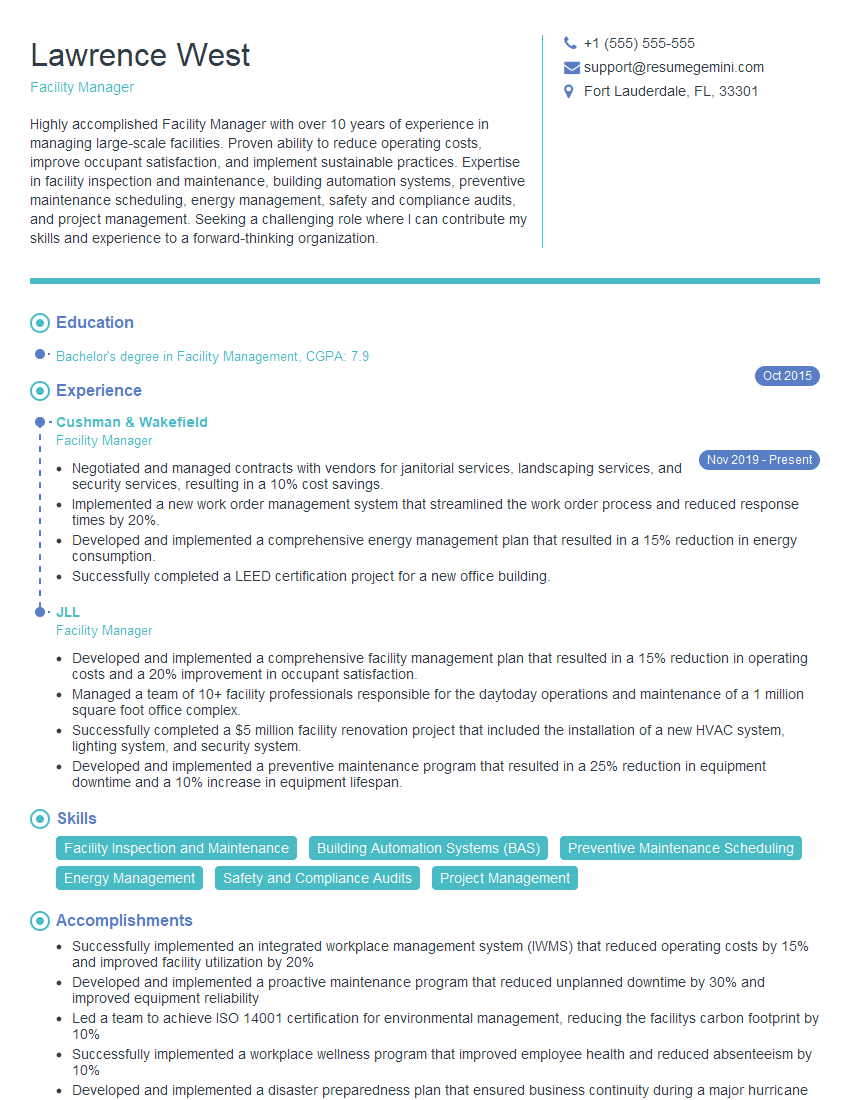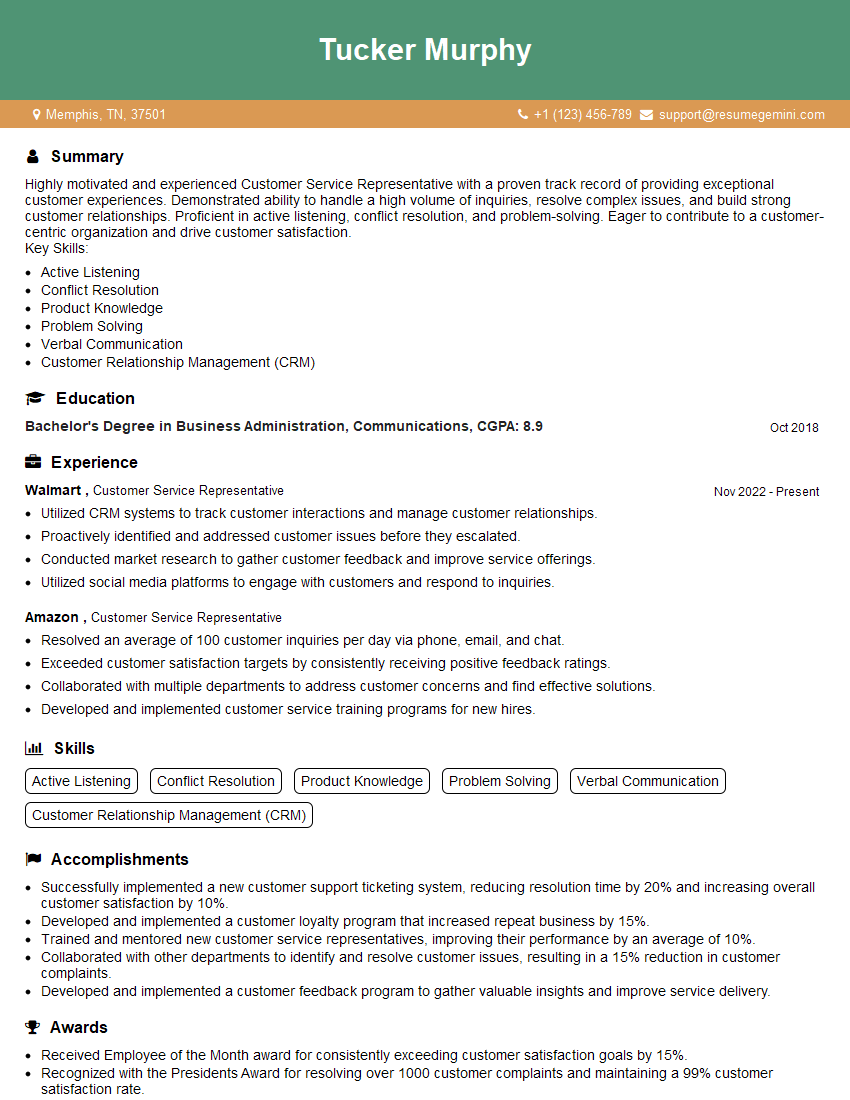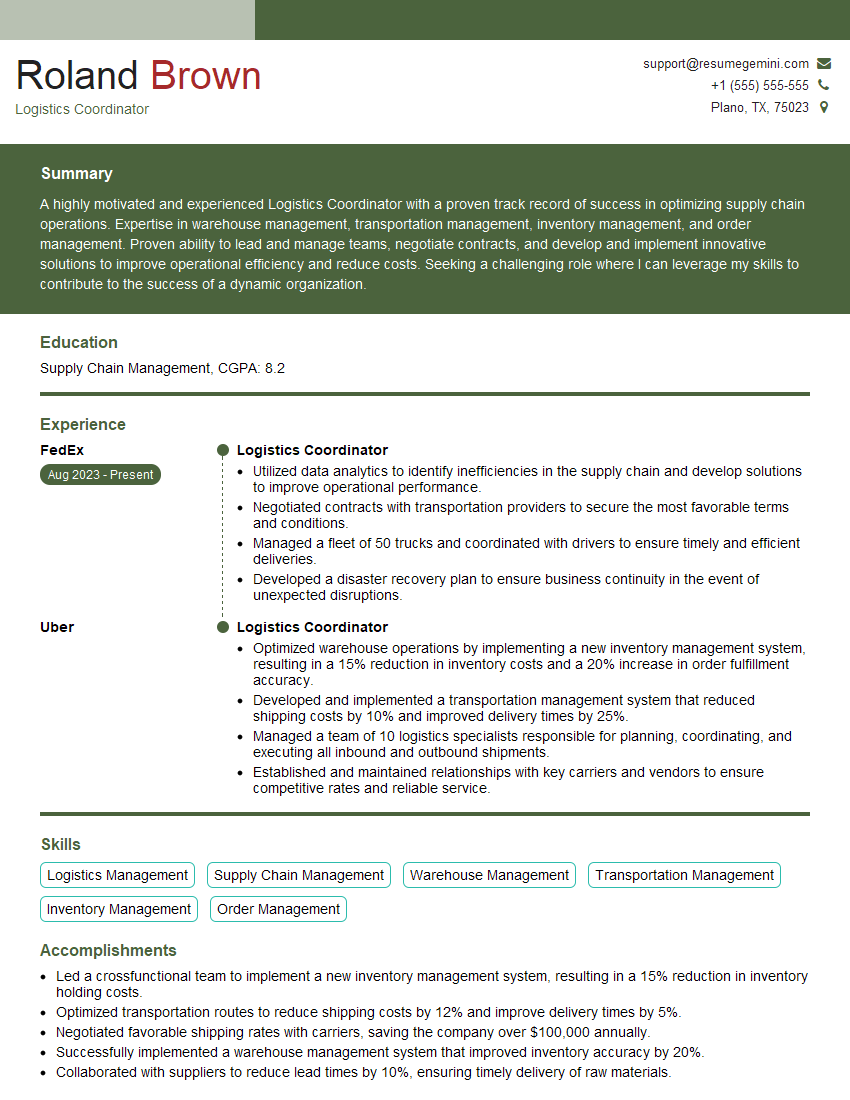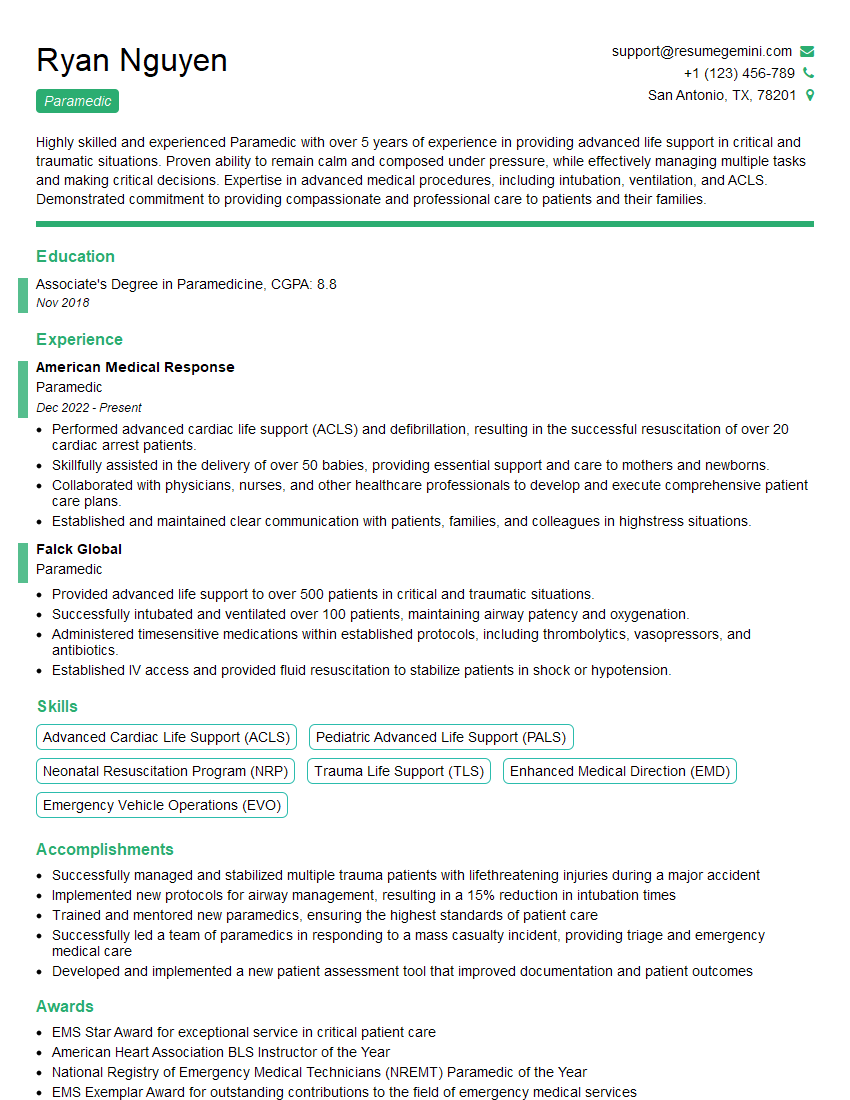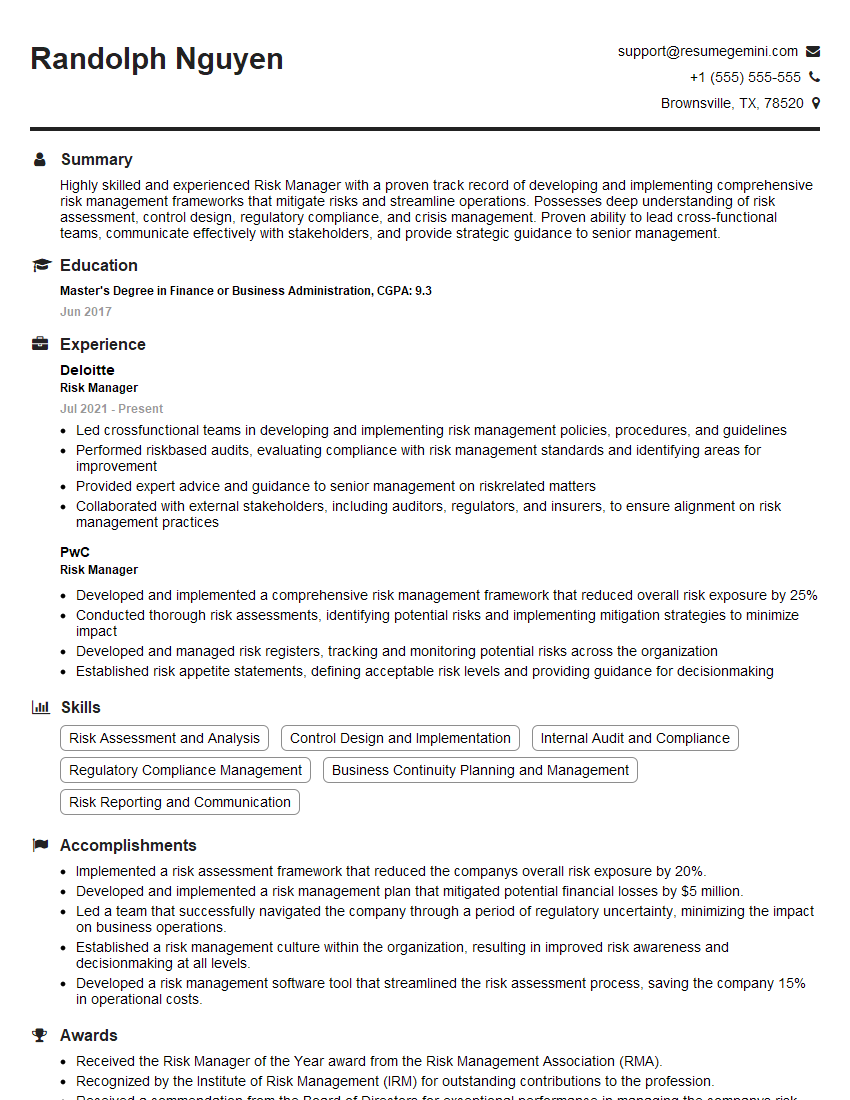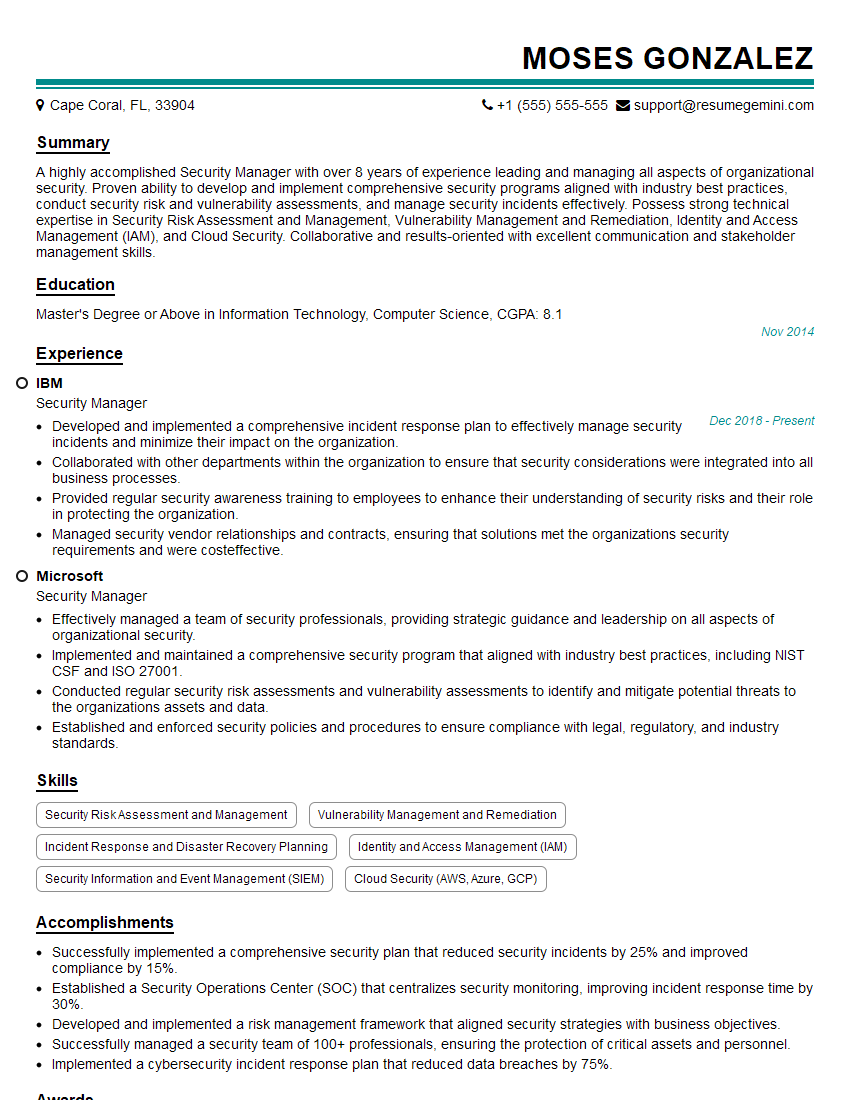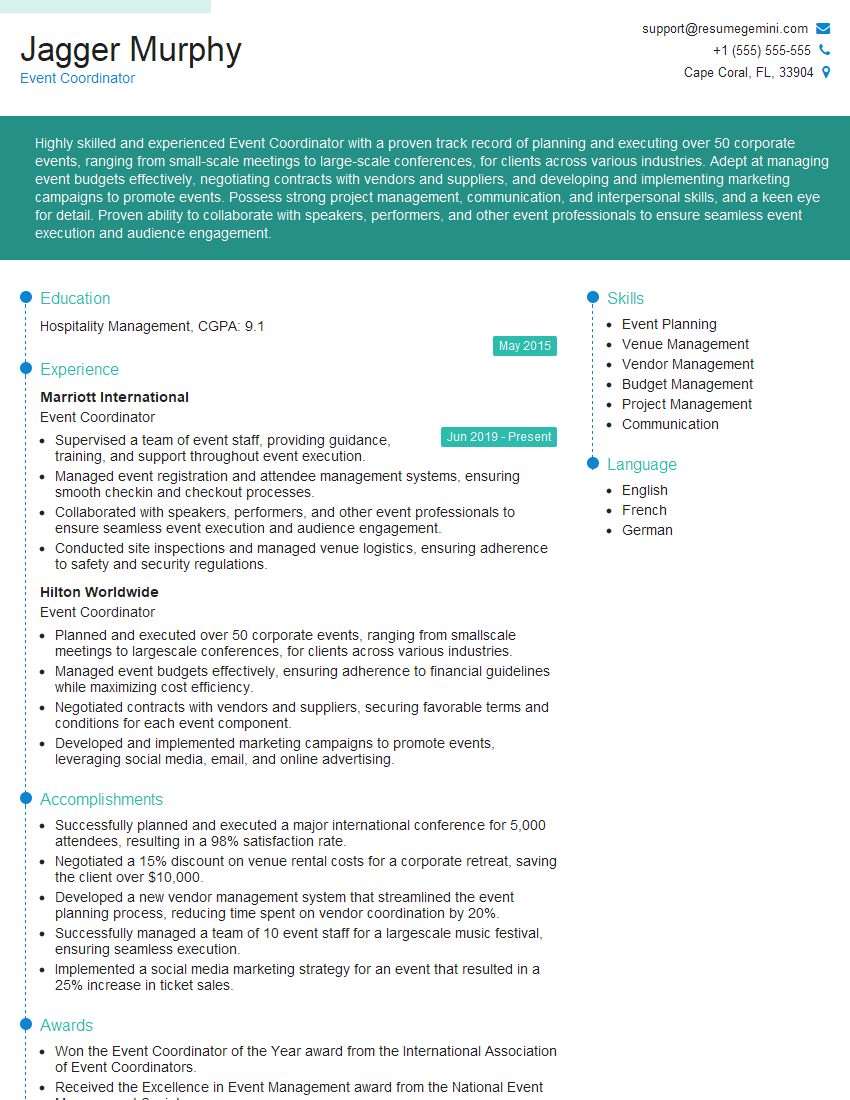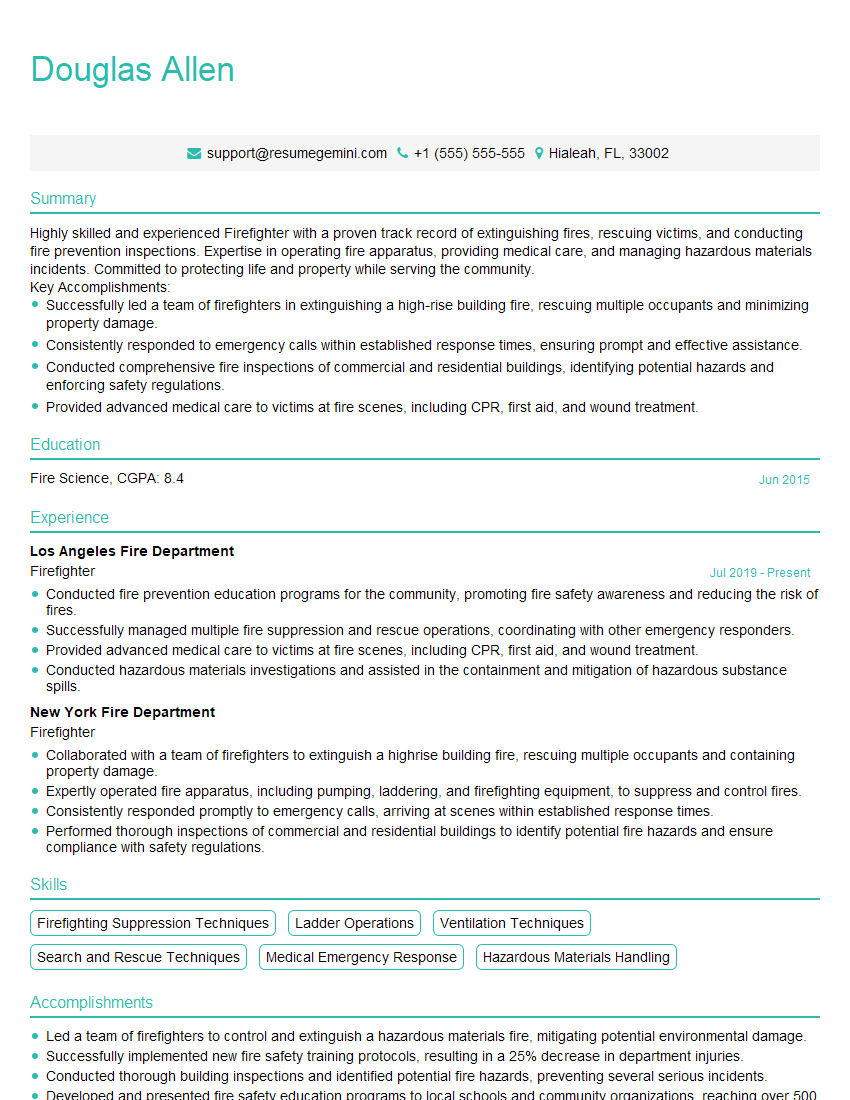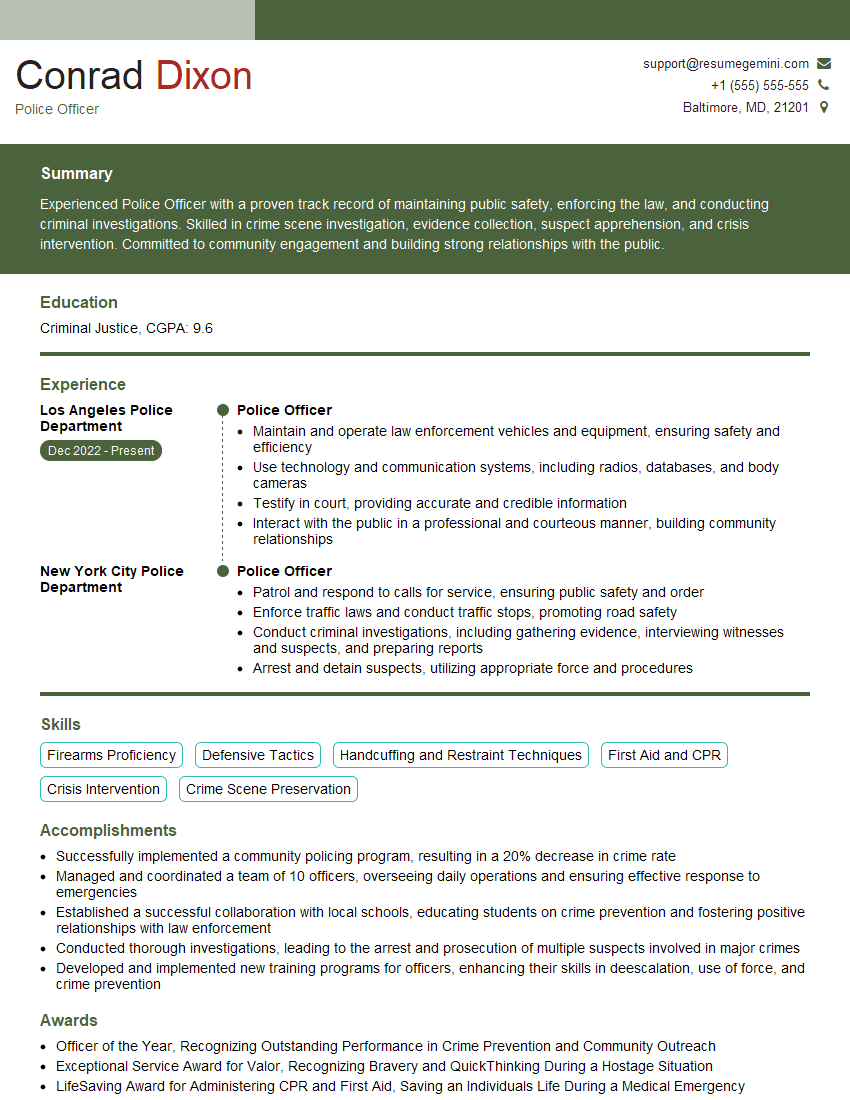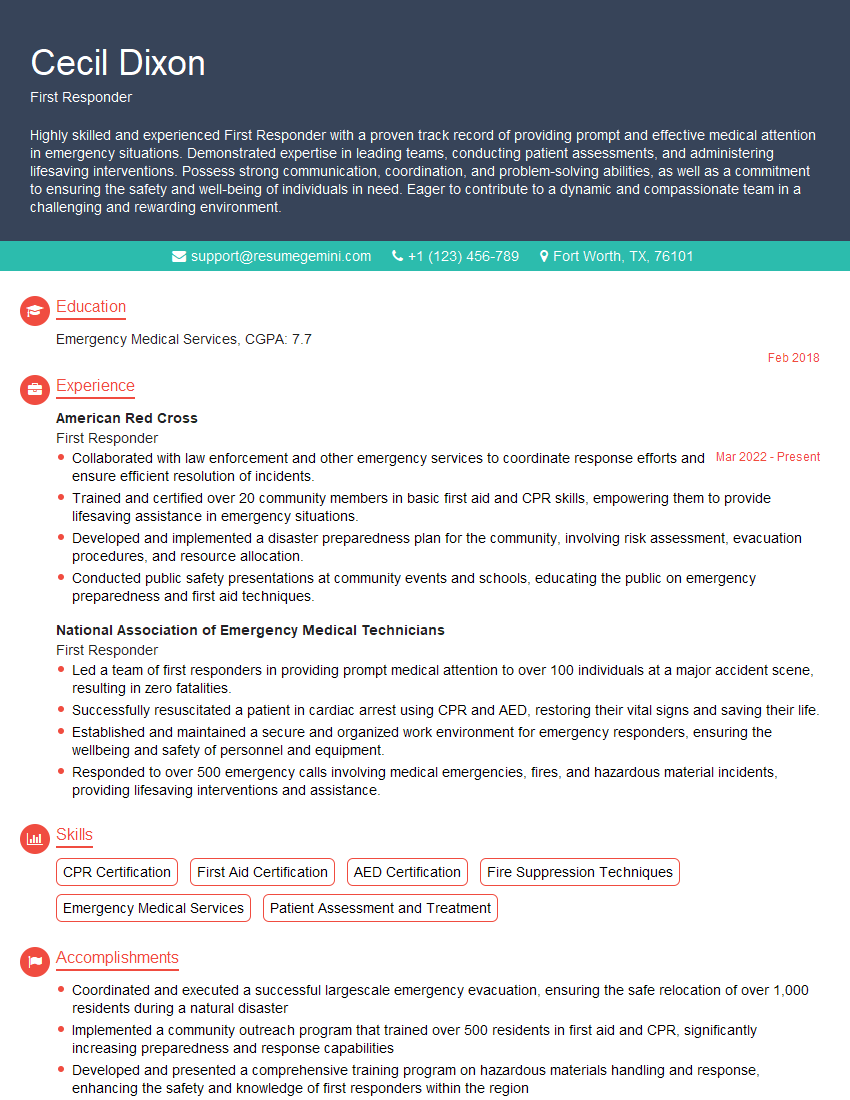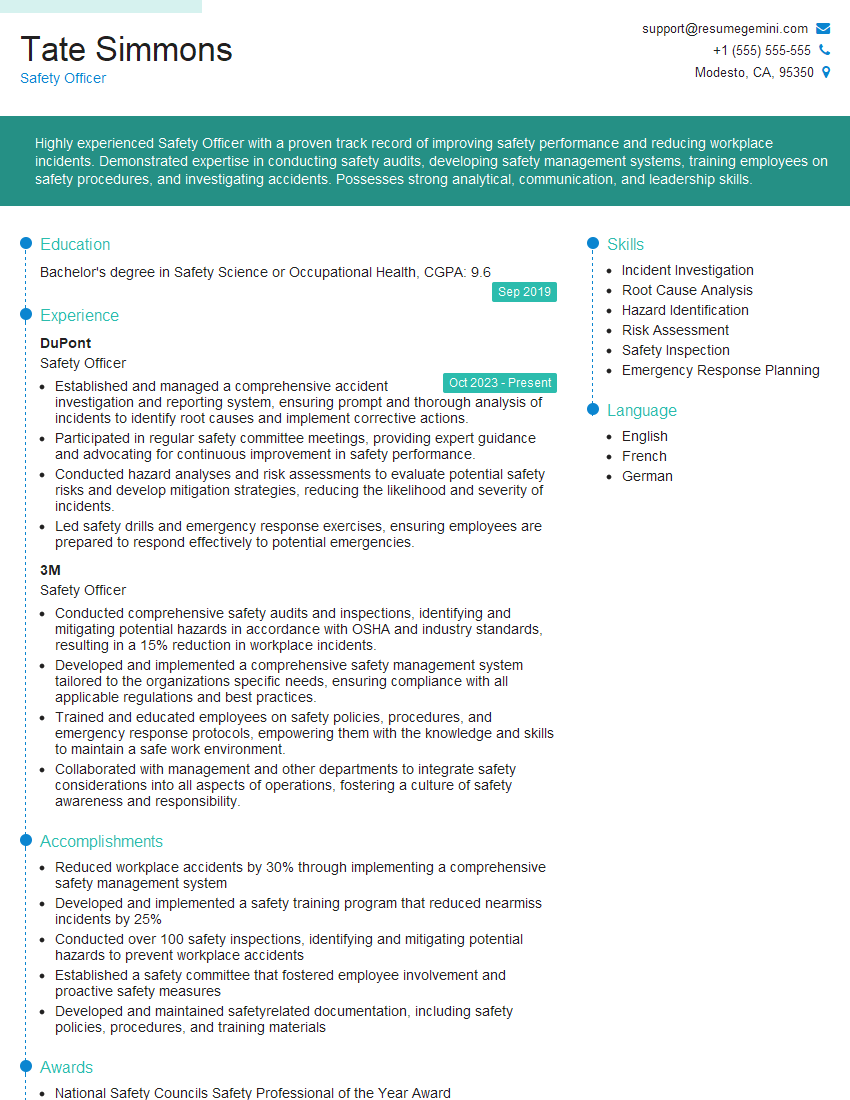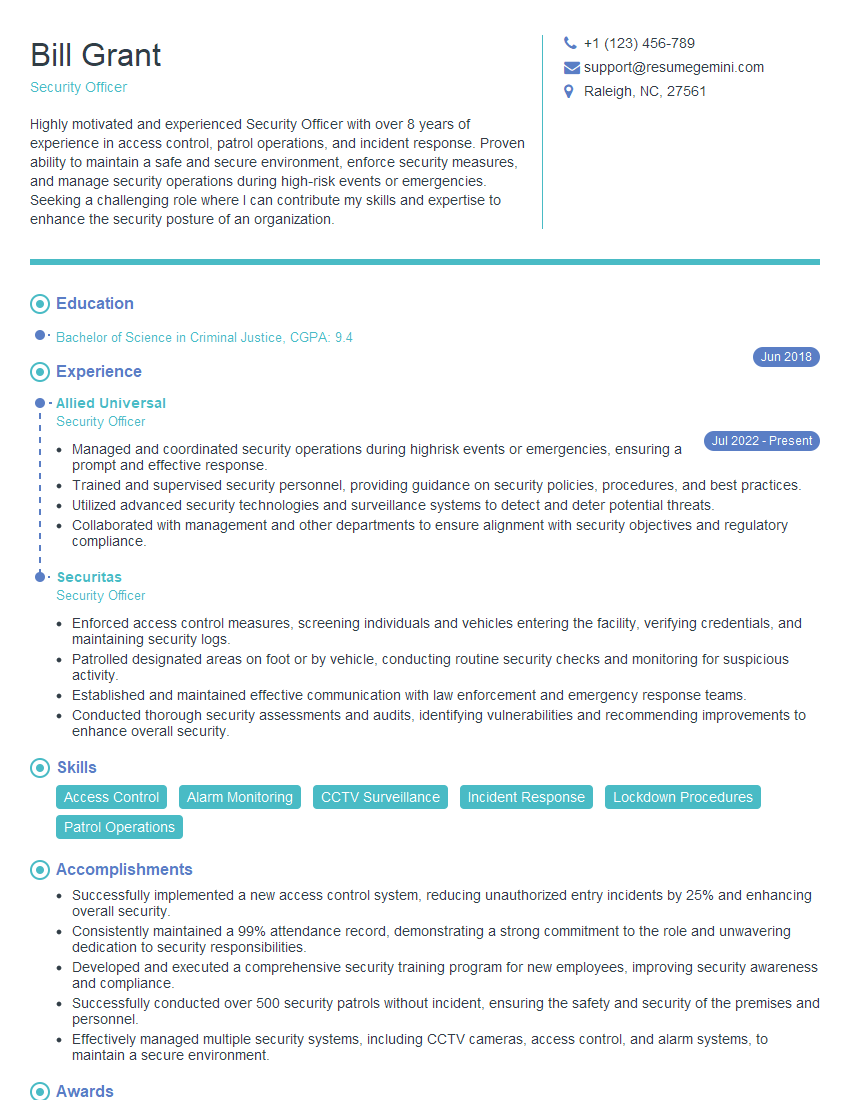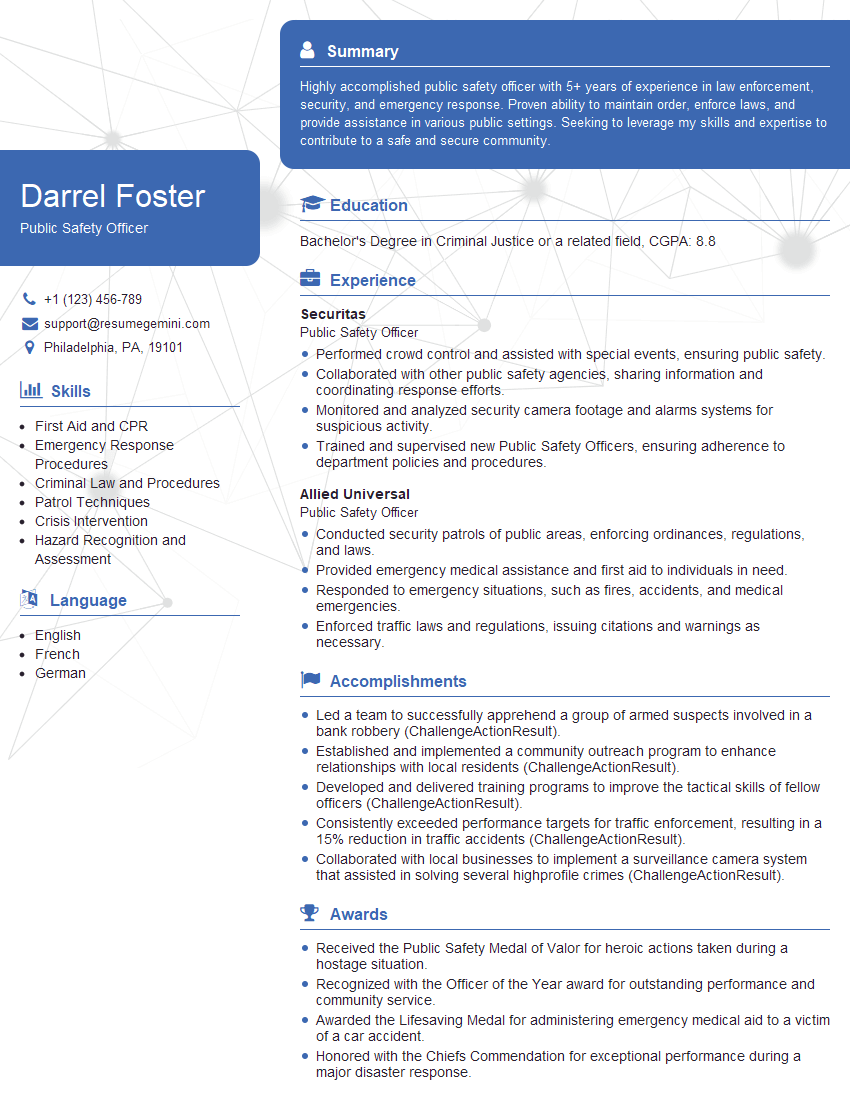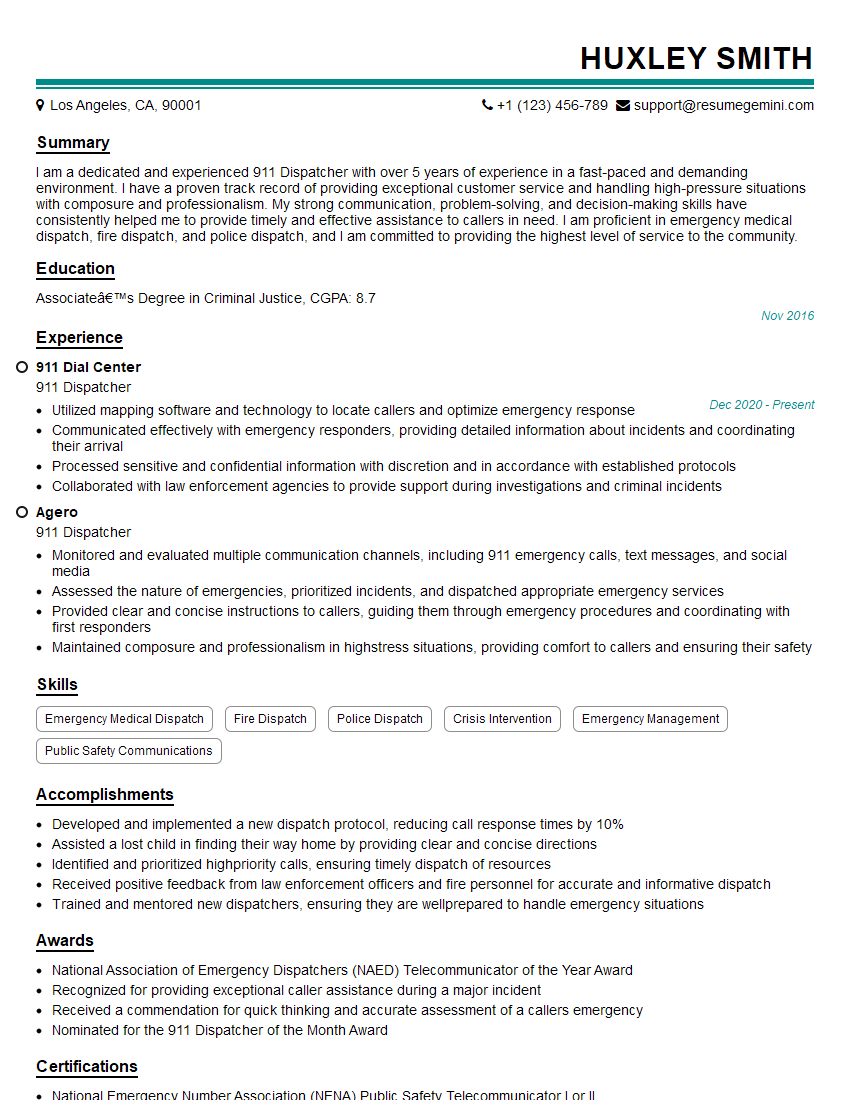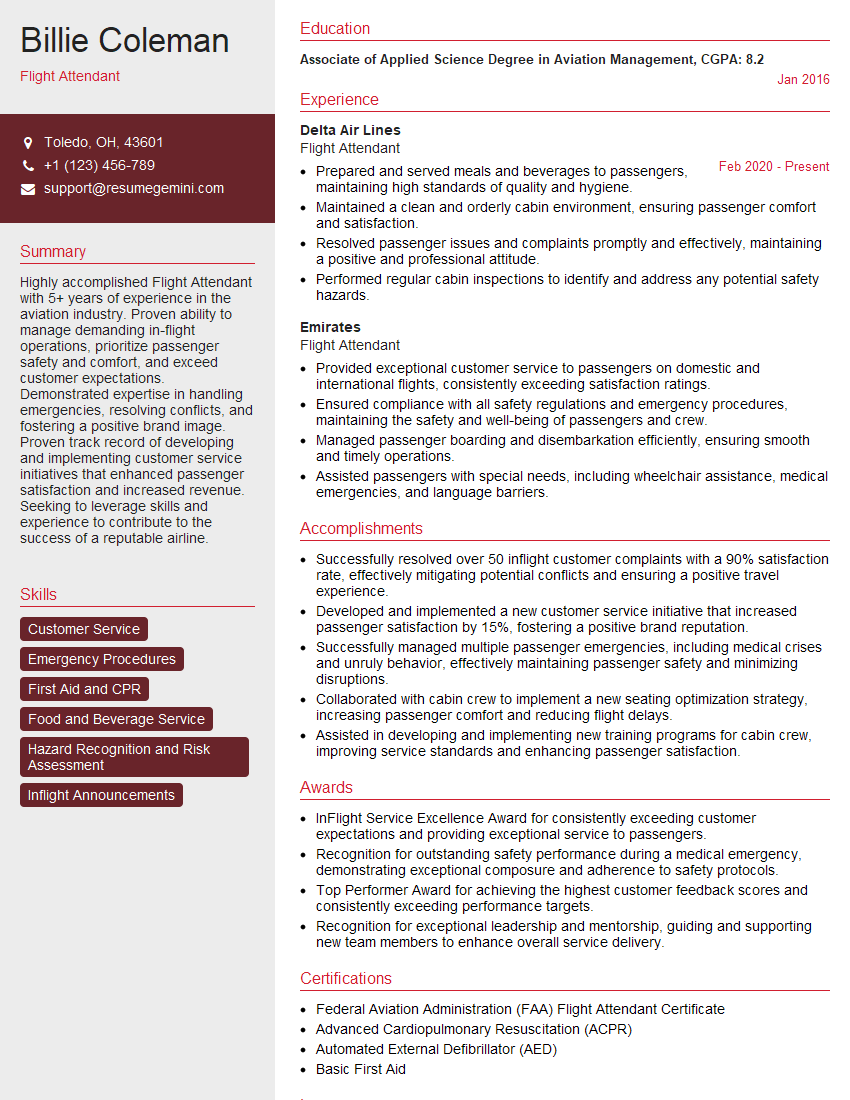The thought of an interview can be nerve-wracking, but the right preparation can make all the difference. Explore this comprehensive guide to Handle Emergencies and Provide Assistance interview questions and gain the confidence you need to showcase your abilities and secure the role.
Questions Asked in Handle Emergencies and Provide Assistance Interview
Q 1. Describe your experience handling a critical incident.
During my time as a [Your Profession/Role], I was involved in a critical incident where a major equipment malfunction threatened to cause a significant production halt and potential safety hazard. The malfunction resulted in a rapid increase in system pressure, triggering several alarms.
My immediate response involved swiftly activating the emergency shutdown protocol, which I’d regularly trained for. This minimized immediate risks. Next, I calmly assessed the situation, systematically checking gauges and sensors to understand the extent of the problem. I then communicated the emergency clearly and concisely to my supervisor and the maintenance team, providing them with the crucial data I had gathered. This allowed for a coordinated and effective response. Finally, I assisted the maintenance team in troubleshooting and repairing the equipment, ensuring the facility’s safe return to operation.
This experience highlighted the importance of clear communication, swift decision-making, and a calm demeanor under immense pressure. It underscored the value of well-rehearsed emergency procedures and thorough equipment knowledge.
Q 2. What is your approach to prioritizing tasks during an emergency?
Prioritizing tasks during an emergency relies heavily on a structured approach. I employ a method I like to call the ‘Life, Limb, and Logistics’ system.
- Life: This prioritizes immediate threats to life and safety. For example, rescuing individuals from immediate danger takes precedence over everything else.
- Limb: This focuses on preventing further injuries or property damage. This could involve securing a hazardous spill before it spreads or isolating a malfunctioning piece of equipment.
- Logistics: This addresses the remaining issues, such as contacting authorities, arranging for repairs, or managing the aftermath. This category is handled after the immediate threats have been addressed.
This system ensures that resources are allocated efficiently and effectively, reducing overall chaos and improving the likelihood of a successful outcome. It also promotes a sense of calm and order in an otherwise stressful situation.
Q 3. How do you maintain composure under pressure?
Maintaining composure under pressure is a skill honed over time through training and experience. It relies on a combination of mental and physical strategies.
- Deep Breathing Exercises: Slow, deep breaths help regulate heart rate and reduce feelings of panic.
- Positive Self-Talk: Reminding myself of past successes and focusing on the task at hand helps maintain confidence.
- Structured Approach: Employing systematic procedures rather than reacting instinctively minimizes the risk of errors.
- Preparation and Training: Regular drills and simulations instill confidence and reduce anxiety when faced with real-world emergencies.
In essence, it’s about proactively managing my stress response, transforming anxiety into focused action. Think of it like a conductor of an orchestra – they remain calm even amidst the complex interplay of instruments, ensuring a harmonious outcome.
Q 4. Explain your understanding of risk assessment in emergency situations.
Risk assessment in emergencies involves a systematic process of identifying, analyzing, and prioritizing hazards to determine the likelihood and potential severity of an adverse event. This process is crucial for making informed decisions and developing effective mitigation strategies.
My approach typically includes:
- Identifying Hazards: This involves thoroughly scanning the environment to identify potential sources of danger, such as structural instability, hazardous materials, or potential equipment failures.
- Analyzing Risks: This stage focuses on determining the likelihood of each hazard occurring and the potential severity of the consequences. I use a combination of qualitative and quantitative methods where appropriate.
- Prioritizing Risks: Risks are ranked according to their potential impact and likelihood, allowing resources to be allocated effectively.
- Developing Mitigation Strategies: Once risks are identified and prioritized, strategies are developed to minimize or eliminate the hazards. This may include evacuations, protective equipment use, or alternative procedures.
A well-conducted risk assessment minimizes the chance of an incident escalating into a major disaster. It’s like checking the weather forecast before a hike—you might still go, but you prepare differently depending on the prediction.
Q 5. How do you communicate effectively during a crisis?
Effective communication during a crisis is paramount. It ensures a coordinated response, minimizes confusion, and enhances overall safety. My approach focuses on clarity, conciseness, and active listening.
- Clear and Concise Messaging: Using plain language and avoiding jargon, I ensure everyone understands the situation and their role.
- Multiple Communication Channels: Utilizing various methods like radios, phones, and visual aids ensures that messages reach everyone involved.
- Active Listening: Paying close attention to others’ input allows for a more informed and coordinated response.
- Regular Updates: Providing regular updates keeps everyone informed and reduces anxiety.
- Documentation: Meticulously documenting all communication and actions ensures accountability and provides valuable data for future improvement.
Imagine a fire brigade—their effective communication ensures everyone knows where to go, what to do, and who’s responsible for each task. This is the core principle for effective crisis communication.
Q 6. How would you handle a situation where multiple emergencies occur simultaneously?
Simultaneous emergencies require a swift and decisive approach. My strategy revolves around prioritization and delegation.
Firstly, I’d quickly assess the severity of each emergency using the ‘Life, Limb, Logistics’ system outlined previously. The most critical emergencies demanding immediate attention would receive top priority. Secondly, I would delegate tasks to other capable individuals, clearly defining responsibilities and timelines. Open and continuous communication is vital here to coordinate efforts and avoid duplication. Finally, I would monitor the situation closely, adjusting resource allocation as needed based on evolving circumstances. Regularly reassessing the situation allows for adapting to dynamic conditions.
Imagine a hospital with multiple patients needing immediate care – a triage system is used to prioritize who gets immediate treatment based on their condition. This illustrates the need for a structured approach when dealing with concurrent crises.
Q 7. Describe your experience with emergency protocols and procedures.
Throughout my career, I have extensive experience with various emergency protocols and procedures. This includes [Mention specific protocols and procedures, e.g., OSHA regulations, HAZMAT protocols, fire safety procedures, evacuation plans etc.]. I am proficient in understanding and following these protocols, ensuring compliance and minimizing risks. Regular participation in training exercises and drills has further solidified my understanding and ability to implement them efficiently and effectively.
For instance, my experience with HAZMAT protocols involves knowing how to identify, contain, and report hazardous material spills. I have completed training on incident command systems which enables me to effectively manage responses during large-scale emergencies. This comprehensive knowledge and experience enable me to react calmly, decisively and effectively during real-world situations, minimizing risks and maximizing positive outcomes.
Q 8. How do you delegate tasks effectively during an emergency?
Effective delegation during an emergency hinges on a clear understanding of individual skills, the urgency of tasks, and maintaining clear communication. It’s not about simply assigning tasks, but about strategically allocating resources for maximum impact.
- Assess the Situation: First, I’d quickly assess the emergency’s scope and identify the most critical tasks needing immediate attention.
- Identify Team Strengths: Then, I would mentally (or via a quick team briefing, if time allows) review the skills and experience of my team members. Who’s best suited for each task? This might involve considering medical expertise, technical skills, or even leadership qualities for coordinating efforts.
- Assign Tasks Clearly: When assigning tasks, I prioritize clear, concise instructions. Ambiguity is the enemy of efficiency in an emergency. This includes specifying deadlines, expected outcomes, and reporting mechanisms.
- Monitor Progress & Adapt: I wouldn’t just assign and forget. I’d monitor progress and be ready to adjust task assignments or offer support based on the evolving situation. Flexibility is key.
For example, during a large-scale building evacuation, I wouldn’t simply yell ‘everyone get out!’ Instead, I’d assign specific individuals to direct traffic flow at exits, others to assist those with mobility challenges, and another to communicate with emergency services. This organized approach is far more effective than chaos.
Q 9. Describe a time you had to make a quick, critical decision under pressure.
During a severe winter storm, our facility lost power. A crucial piece of medical equipment—a life support system—began to show a critical battery low warning. We had a limited number of backup batteries. This meant I had to make a swift decision on which patient to prioritize.
The pressure was immense. I had to assess each patient’s condition, the remaining battery life, and the potential consequences of delaying a battery switch for any patient. I chose the patient with the most immediate and severe need, based on objective medical data and professional judgment. It was a gut-wrenching decision, but ultimately the right one. Fortunately, we received backup power soon afterward, and all patients were safe.
Q 10. How do you ensure the safety of yourself and others during an emergency?
Ensuring safety during an emergency is paramount, and it’s a two-pronged approach focusing on both personal safety and the well-being of others.
- Personal Safety: This starts with situational awareness—assessing risks before acting. It involves following established safety protocols, using personal protective equipment (PPE) when appropriate, and understanding evacuation procedures. In a fire, for example, knowing where the nearest exits are could save my life.
- Safety of Others: Protecting others involves directing them to safety, providing assistance to those injured or incapacitated, and maintaining calm and order. This could include using clear communication to guide people out of harm’s way or administering first aid where necessary.
Think of it like a firefighter: they train for personal safety through equipment and techniques, while simultaneously acting to protect others. It’s not a trade-off, but a simultaneous process.
Q 11. How do you assess the severity of an emergency situation?
Assessing the severity of an emergency involves a quick, systematic evaluation using a framework. I use a combination of observations, information gathering, and established protocols.
- Immediate Hazards: First, I’d identify immediate threats to life and safety. Is there an active fire? Are people injured? Are there hazardous materials leaking?
- Casualty Numbers: How many people are affected? A single serious injury warrants a different response than a mass casualty incident.
- Resource Availability: Do we have enough personnel, equipment, and resources to handle the situation? Or do we need to request backup?
- Contagion Risk: Is there a risk of contagion? If so, isolation and infection control measures become critical.
The combination of these factors determines the urgency and severity. For example, a small kitchen fire is different from a large building fire, and an individual choking requires a different immediate response than a multiple-vehicle accident.
Q 12. What are your strengths in handling emergency situations?
My strengths in emergency situations include my ability to remain calm under pressure, my quick decision-making skills, and my effective communication and leadership qualities. I’m comfortable taking charge and delegating tasks effectively.
I’m also adept at thinking strategically and adapting to changing circumstances. My experience has allowed me to develop a strong situational awareness, enabling me to quickly assess risks and prioritize actions accordingly. Finally, I’m a strong team player and believe collaboration is key to effective emergency response.
Q 13. What are your weaknesses in handling emergency situations?
While I’m generally strong under pressure, I sometimes find it challenging to delegate tasks to people I’m not completely familiar with. I’m working on improving my ability to trust and rely on the capabilities of others quickly in high-stakes situations. I’m also conscious that I could become overly focused on a single critical aspect, potentially overlooking smaller, but still important, details.
I actively mitigate these weaknesses by practicing delegation techniques and through regular training exercises which simulate high-pressure environments, allowing me to test and refine my approach.
Q 14. How do you stay updated on emergency response best practices?
Staying updated on emergency response best practices is an ongoing process. I use a multi-faceted approach.
- Professional Development Courses: I regularly attend workshops and training sessions on advanced first aid, emergency response protocols, and disaster management.
- Industry Publications and Journals: I subscribe to relevant journals and online resources to keep abreast of the latest research and best practices.
- Networking and Collaboration: I actively participate in professional networks and collaborate with colleagues to share knowledge and insights. This includes attending conferences and engaging with emergency response professionals.
- Regular Drills and Simulations: Participating in regular drills and simulations allows me to apply my knowledge in a practical setting and identify areas for improvement.
Continuous learning is essential in this field because emergency situations are dynamic and require ongoing adaptation to new challenges and advancements in the field.
Q 15. How do you manage stress and fatigue during prolonged emergency situations?
Managing stress and fatigue during prolonged emergencies is crucial for maintaining effectiveness and safety. It’s like running a marathon; you need a strategy to pace yourself and avoid burnout. My approach is multifaceted:
- Prioritization and Time Management: I focus on the most critical tasks first, delegating where possible. This prevents feeling overwhelmed and ensures efficiency.
- Self-Care: Short breaks for hydration, light exercise, and mindful breathing are essential. Even a few minutes can significantly improve focus and reduce stress. Think of it as refueling your engine.
- Teamwork and Support: Open communication with colleagues is key. Sharing the load and offering support to each other helps manage stress collectively. We’re a team, and we rely on each other.
- Mental Resilience Techniques: I utilize techniques like positive self-talk and visualization to maintain a positive outlook and manage negative thoughts. This helps to avoid mental exhaustion.
- Post-Incident Debriefing: Structured debriefing sessions are vital for processing the experience, identifying areas for improvement, and supporting team members’ mental well-being. This is about learning from experience and supporting each other’s mental health.
In a recent wildfire response, maintaining this balance allowed me to work effectively for 72 hours straight, ensuring the safety of both responders and the community. Prioritizing tasks, taking short breaks, and relying on team support proved invaluable.
Career Expert Tips:
- Ace those interviews! Prepare effectively by reviewing the Top 50 Most Common Interview Questions on ResumeGemini.
- Navigate your job search with confidence! Explore a wide range of Career Tips on ResumeGemini. Learn about common challenges and recommendations to overcome them.
- Craft the perfect resume! Master the Art of Resume Writing with ResumeGemini’s guide. Showcase your unique qualifications and achievements effectively.
- Don’t miss out on holiday savings! Build your dream resume with ResumeGemini’s ATS optimized templates.
Q 16. Describe your experience working as part of an emergency response team.
My experience working within emergency response teams has been incredibly rewarding and challenging. I’ve been a part of several teams, including flood relief operations and search and rescue missions. In these situations, teamwork is paramount. It’s not simply about individual skill, but how effectively we work together.
- Clear Roles and Responsibilities: Each team member has a defined role and understands their responsibilities, ensuring efficient collaboration and minimizing confusion.
- Effective Communication: We utilize various communication channels—radios, satellite phones, and even hand signals—to coordinate actions and share information rapidly and reliably. Clear, concise communication is key to success.
- Adaptability and Flexibility: Situations are dynamic. We must be flexible and adapt our strategies based on evolving circumstances. It’s like navigating a constantly shifting landscape.
- Shared Leadership: There’s often a clear leader, but shared leadership and the ability to step up when needed are vital. Each member’s contributions and expertise are valued.
- Post-Incident Analysis: Following each operation, we conduct a thorough debrief to identify what went well, what could be improved, and how to better prepare for future events. Continuous improvement is paramount.
For example, during a major flood, our team efficiently coordinated evacuation efforts, using real-time data analysis to direct resources and minimize risks. This involved seamless communication and flexible decision-making based on the changing situation.
Q 17. How do you debrief after an emergency situation?
Debriefing after an emergency situation is critical for both physical and mental well-being, as well as improving future responses. It’s not just about recounting events; it’s a structured process aimed at learning and growth.
- Immediate Debriefing: A short, informal debrief immediately after the event allows team members to share initial observations and address immediate concerns.
- Formal Debriefing: A more structured session, often held within 24-48 hours, provides a comprehensive review of the event. This covers actions taken, challenges encountered, and areas for improvement.
- Focus on Emotional Well-being: Debriefing creates a safe space for team members to share emotions and process their experiences. This is vital for preventing burnout and promoting resilience.
- Identifying Lessons Learned: The primary goal is to identify what worked well, what didn’t, and how future responses can be improved. Documentation of these lessons is essential for continuous learning.
- Support Resources: Access to mental health professionals and support services should be made available to team members during and after debriefing sessions.
In one instance, a post-incident debriefing revealed a communication breakdown that almost led to a serious accident. This led to changes in our communication protocols and improved safety measures.
Q 18. How do you adapt your communication style to different individuals during a crisis?
Adapting communication style during a crisis is paramount. You’re dealing with people under extreme stress and varying levels of understanding. It’s about tailoring your approach to be effective and empathetic.
- Active Listening: Paying close attention to both verbal and nonverbal cues is vital. Understanding their emotional state informs your communication strategy.
- Clear and Concise Language: Avoid jargon and technical terms. Speak in simple, direct language that everyone can understand. Simplicity is key in high-stress situations.
- Empathy and Compassion: Show empathy and understanding. People are scared and vulnerable. Acknowledge their feelings and offer reassurance.
- Visual Aids: Using maps, diagrams, or other visual aids can be helpful in conveying information quickly and clearly, especially when language barriers exist.
- Nonverbal Communication: Body language and tone of voice are just as important as words. Maintaining a calm and reassuring demeanor can help to alleviate anxiety.
For instance, when communicating with a traumatized individual, I would use a calm, gentle tone, offering reassurance and avoiding overwhelming them with information. Conversely, I would use a more direct and assertive approach with someone who needed clear and concise instructions during a rescue operation.
Q 19. Describe a time you had to overcome a communication barrier during an emergency.
During a building collapse, we encountered a significant communication barrier – a survivor who only spoke Mandarin. While I don’t speak Mandarin, a team member did.
The initial challenge was getting the survivor’s location and medical status. We used a combination of gestures, a translation app (with limited success due to network connectivity issues), and eventually, the bilingual team member’s presence was invaluable. This highlights the need for diverse skills and resources within the team.
This experience underscored the importance of having multilingual team members or readily available translation resources. We subsequently updated our emergency response protocols to incorporate such resources effectively.
Q 20. How do you use technology to support emergency response efforts?
Technology plays a vital role in supporting emergency response efforts. It enhances communication, data analysis, and resource allocation. Think of it as our toolbox for efficient and effective action.
- Communication Systems: Two-way radios, satellite phones, and text messaging systems ensure reliable communication even in areas with limited or no cellular service.
- GPS and Mapping: GPS tracking devices and mapping software help locate victims, track responders, and coordinate resources effectively. This is crucial in large-scale emergencies.
- Data Analysis: Real-time data analysis of weather patterns, traffic flow, and other relevant factors allows for more informed decision-making.
- Social Media Monitoring: Monitoring social media can provide valuable situational awareness and identify areas requiring immediate attention.
- Drones and Aerial Surveillance: Drones equipped with cameras and sensors can provide crucial aerial views of the situation, assessing damage and identifying victims.
For example, during a hurricane, we utilized drone imagery to assess flood levels and direct rescue teams to areas of greatest need, significantly enhancing our response time and efficiency.
Q 21. How do you handle conflicting priorities during an emergency?
Handling conflicting priorities during an emergency requires a structured approach, prioritizing tasks based on urgency and impact. It’s like a triage system for tasks.
- Prioritization Matrix: Using a matrix that considers both urgency and impact helps to rank tasks effectively. High urgency, high impact tasks take precedence.
- Resource Allocation: Determine available resources (personnel, equipment) and allocate them to the highest-priority tasks. Optimization of resource utilization is key.
- Clear Communication: Maintain transparent communication with all stakeholders regarding the prioritization decisions and the rationale behind them. Transparency builds trust and reduces confusion.
- Flexibility and Adaptation: Be prepared to adjust priorities as the situation evolves. Emergencies are dynamic; responses must be too. Think of it as continuous refinement of strategy.
- Delegate Effectively: Delegate tasks to appropriate team members to optimize use of skills and available time. This allows for focused efforts on the most critical priorities.
For example, during a multi-vehicle accident, we had to prioritize immediate medical attention for the most critically injured, secure the scene, and then address traffic management. Using a clear prioritization matrix allowed us to manage the conflicting demands effectively.
Q 22. Describe your experience with providing first aid or CPR.
I’m certified in both First Aid and CPR, having regularly renewed my certifications over the past 10 years. My experience spans a wide range of situations, from minor injuries like cuts and scrapes to more serious incidents involving loss of consciousness and respiratory distress. For instance, while volunteering at a local marathon, I assisted a runner experiencing a severe allergic reaction. I was able to quickly assess the situation, administer an epinephrine auto-injector (following protocol), and call emergency services, ultimately contributing to their successful recovery. In another instance, I provided CPR to an elderly man who collapsed in a supermarket; although paramedics arrived quickly, my immediate actions were crucial in maintaining his circulation until their arrival. My training emphasizes a methodical approach – checking for responsiveness, activating emergency medical services, administering appropriate first aid, and ensuring patient safety until professional help arrives.
Q 23. How do you ensure the accuracy and timeliness of information during an emergency?
Accuracy and timeliness are paramount in emergency situations. I ensure accuracy by relying on verified sources – primarily established emergency response protocols and official channels like emergency medical dispatch. I avoid spreading unsubstantiated rumors or information from unreliable sources. Timeliness is achieved by prioritizing efficient communication. This includes using clear and concise language when relaying information to emergency services, using appropriate terminology to accurately describe the situation, and keeping communication channels open to provide continuous updates as the situation evolves. For example, during a building fire, I’d immediately relay accurate details such as the building’s location, the number of people trapped, and the nature of the fire (e.g., location and intensity) to the dispatch center.
Q 24. How do you deal with difficult or uncooperative individuals during an emergency?
Dealing with uncooperative individuals during an emergency requires a calm, empathetic, and assertive approach. I prioritize de-escalation techniques; understanding their perspective is crucial before attempting to direct their actions. This often involves active listening and demonstrating genuine concern for their well-being, even while firmly enforcing safety regulations. For example, if someone refuses evacuation during a fire, I’d try to explain the danger calmly and clearly, emphasizing potential risks and offering assistance. If persuasion fails, I would coordinate with other responders to safely ensure their evacuation, possibly involving law enforcement if needed, while always prioritizing the safety of all involved.
Q 25. Describe a time you had to make a difficult ethical decision during an emergency.
During a multi-vehicle accident, I faced an ethical dilemma. Two individuals were critically injured; one required immediate CPR, and the other needed urgent attention for severe bleeding. Given limited personnel, I had to decide who to prioritize. After quickly assessing the situation (using my training on triage), I determined that the individual with the most immediate life-threatening condition (the one requiring CPR) needed my immediate attention first, ensuring I provided adequate instructions and delegated the bleeding control to other responders. This decision was difficult but necessary to maximize the chances of survival for both individuals. I subsequently documented every detail of the decision-making process for review.
Q 26. How do you maintain confidentiality when handling sensitive information related to an emergency?
Maintaining confidentiality is crucial. I adhere strictly to privacy regulations (like HIPAA if applicable) and only share information with authorized personnel involved in the emergency response and recovery process. This includes using secure communication channels and avoiding any casual discussion of sensitive information. For example, during a medical emergency involving a patient’s personal health data, I’d only share necessary medical information with paramedics and hospital staff involved in their treatment, and never with bystanders or on social media.
Q 27. How do you identify and mitigate potential risks before they escalate into emergencies?
Risk mitigation involves proactive measures. This begins with a thorough risk assessment, identifying potential hazards (e.g., fire hazards, electrical risks, hazardous materials) specific to the environment. Then, I implement preventative measures like ensuring proper safety equipment is available and functional, implementing safety protocols, and conducting regular safety inspections. For instance, before a large public event, I’d assess the site for potential hazards, plan escape routes, and ensure emergency services are readily accessible. This proactive approach reduces the likelihood of emergencies escalating into major incidents.
Q 28. How do you learn from past experiences to improve your emergency response skills?
Learning from past experiences is continuous. After every incident, I conduct a thorough after-action review. This involves reflecting on what went well, identifying areas for improvement, and documenting lessons learned. I use this information to refine my skills, update my knowledge base (e.g., through continuing education courses), and adapt my approach to enhance future responses. This process ensures ongoing improvement in my emergency response capabilities, leading to more efficient and effective interventions in subsequent emergencies. This self-reflection and continuous learning is crucial to maintaining optimal preparedness.
Key Topics to Learn for Handle Emergencies and Provide Assistance Interview
- Assessing the Situation: Understanding the urgency and scope of the emergency. This includes recognizing immediate threats to safety and prioritizing actions based on risk assessment.
- Prioritizing Actions: Developing a systematic approach to handling multiple issues simultaneously, focusing on the most critical needs first. This might involve calmly delegating tasks where appropriate.
- Communication Skills: Effectively communicating with those involved, including victims, bystanders, and emergency services. This includes active listening, clear instructions, and empathy.
- First Aid & CPR Knowledge: Demonstrating familiarity with basic first aid procedures and CPR techniques, as applicable to the role. This involves understanding limitations and seeking appropriate professional help.
- Safety Procedures: Adhering to safety protocols and regulations relevant to the specific context (e.g., workplace safety, public safety). This may include understanding evacuation procedures or using appropriate safety equipment.
- Problem-Solving & Decision-Making Under Pressure: Explaining your approach to making quick, informed decisions in stressful, high-pressure situations. Use examples to illustrate your thought process.
- Legal & Ethical Considerations: Understanding the legal and ethical implications of actions taken during emergencies. This includes issues of confidentiality and liability.
- Post-Incident Procedures: Describing the steps involved in reporting an incident, documenting actions taken, and cooperating with investigations.
Next Steps
Mastering the art of handling emergencies and providing assistance is crucial for career advancement in many fields. It demonstrates essential skills like problem-solving, leadership, and compassion – traits highly valued by employers. To significantly boost your job prospects, focus on crafting an ATS-friendly resume that showcases these skills effectively. ResumeGemini is a trusted resource that can help you build a professional resume that highlights your abilities. ResumeGemini provides examples of resumes tailored to the “Handle Emergencies and Provide Assistance” skillset, giving you a head-start in creating a compelling application.
Explore more articles
Users Rating of Our Blogs
Share Your Experience
We value your feedback! Please rate our content and share your thoughts (optional).
What Readers Say About Our Blog
Hi, I have something for you and recorded a quick Loom video to show the kind of value I can bring to you.
Even if we don’t work together, I’m confident you’ll take away something valuable and learn a few new ideas.
Here’s the link: https://bit.ly/loom-video-daniel
Would love your thoughts after watching!
– Daniel
This was kind of a unique content I found around the specialized skills. Very helpful questions and good detailed answers.
Very Helpful blog, thank you Interviewgemini team.
